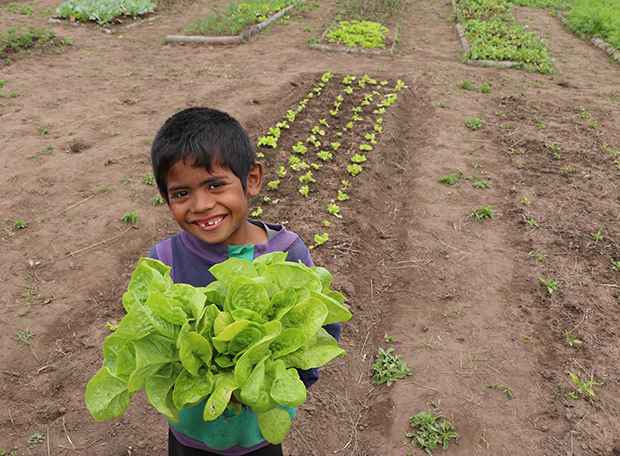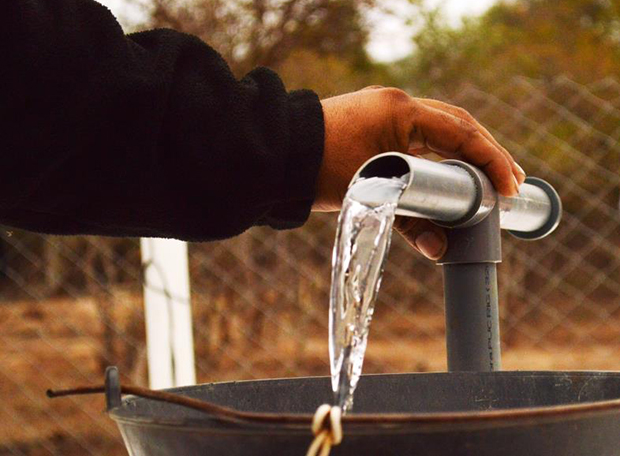The road from Pozo Colorado to Concepcion in Paraguay is nearly 120 miles long. Scattered along it are about 20 indigenous villages, grouped into half a dozen communities. The people here don’t have a lot of the basic things they need, like enough food, clean water or access to medical care or education. But they are determined to get them.
Over the years, CWS has teamed up with respected local organizations to help families in this part of South America, called the Gran Chaco. The few relief organizations working here tend to support short-term programs, which typically last a few months or a year and are too short to ensure the sustainability of the efforts they start. This is particularly true of programs focusing on skill-building, changing long terms behaviors or undertaking advocacy initiatives. Now, CWS is committing to these six communities for the long term. At the beginning of 2018, and with support from Week of Compassion and the Presbyterian Hunger Program, we launched the first year of a five-year program. While there are a lot of different aspects to the work that we will be doing together, the goal is simple: help families in these six communities – over 2,000 people – realize their rights.
Food
Of course, making sure that families have enough nutritious food to eat is a critical part of the program. Most people here aren’t used to having vegetable gardens and eating things like lettuce, carrots, onions and tomatoes. Like in other CWS-supported programs in Latin America, we have established six demonstration gardens – one for every community. Our partner’s agronomist, Cesar, spends a week with families, leading a four- or five-day education session. There’s a little bit of talking about good ideas for gardening, and a lot of hands-on time spent working in the garden.
Each garden contains between seven and 11 types of vegetables and is cared for by a group of local women. Children and youth help out in the garden and learn how to grow the different plants. Families can then include the vegetables in their diets. The goal is to inspire families to build and plant their own gardens. So far more than 200 people are involved in the gardens.
Parallel to establishing vegetable gardens, the project will promote better farming techniques, sustainable livestock management and more efficient honey production. And, critical to ensuring the sustainability of the results, the project will train motivated youth to become agro-ecological community promoters.
Medical Care
Another key part of making sure that families have what they need is medical care. When our partner was having initial conversations with community members, they said that healthcare was one of their top priorities – especially for women. None of these communities have functioning health posts or clinics. In fact, three of them have buildings that were supposed to be clinics that are standing empty. There are a few volunteer health workers here, but they lack some of the things they need most: medicine and ongoing support from the Ministry of Health. Our partner heard the communities and met with the local Ministry of Health. They learned that one of the main challenges for the Ministry is just getting staff out to the communities, since they are remote. A simple solution emerged: program staff would let the Ministry know when they were going out to the villages so they could go with them. Thanks to this partnership, doctors have already started visiting the communities.
Water
And then there’s the challenge of clean water. These communities are in the Gran Chaco, a semi-arid region that spans parts of Paraguay, Argentina and Bolivia. One common theme emerges from communities here, no matter which country they are in: a need for clean water. One resident here told us, “Water is the number one problem. We have a 350-gallon tank, but it isn’t always full of clean water because we lack rain for many months. Then, we must fetch dirty water from the reservoir. Children get sick, and elderly people do, too.”
This is one reason we’re so excited to be launching a multi-year program. This way, we can go in-depth with communities to help them demand and implement long-term changes to improve the situation. Esteban, a water consultant with the program, is providing “water portraits” of each community to recognize their individual needs. Then he will be conducting workshops to get started on the long-term project. The information he’s putting together can also be used to advocate to national or municipal government for more support for water and agriculture.
Roads
Development and humanitarian assistance can get a lot done to help these communities. The government, however, can and must do even more. Take the community of Yakie Axa, for example. Twenty years ago, these indigenous families began claiming their communal lands, which they got a few years ago after many years of struggle. It was a major victory, but one that still hasn’t really been realized. Here’s the thing: that land is 10 miles off the main road, and there’s no road that the families can use to get to it. For two decades now, Yakie Axa has been living in a temporary camp by the side of the road. The soil isn’t good here, and families are struggling. There are half a dozen communities that, like Yakie Axa, are unable to access their land because of lack or poor roads. In response, our partner hosted a meeting earlier this month between indigenous community leaders who demand roads to access their communities with Catholic, Lutheran and Disciples of Christ members as well as lawyers from an organization called TierraViva. Paraguayan churches are now supporting the communities as they petition the Paraguayan government to get the roads they need. Stay tuned for progress!
Women
Indigenous women are responsible for cooking, cleaning, collecting firewood, washing clothes, teaching children, fishing and caring for chickens. They are very shy with visitors and could – and many want to – play a much more active role in community affairs. .A lawyer named Raquel is running workshops for women in these communities that focus on leadership development and self-esteem. Since most women here can’t read, the sessions rely heavily on metaphors and draws on real-life experiences. For example, being a good leader is compared to being a good shepherd. As one woman noted, “I care for my sheep. I do not want to lose them. I know at what time they have to eat and at what time they should come back. I love my animals – I watch after them so they don’t go to the road because a truck can kill them.”
We are eight months into this program, and we are already seeing signs of progress. Demonstration vegetable gardens are flourishing in each of the six communities. Nearly 70 women and youth have shown interest in being promoters, who share what they have learned with their neighbors. Doctors are visiting communities. And in two communities, women have begun to come together to talk about how they can be part of leading their communities into the future. We are proud to be part of this movement in the Paraguayan Chaco region, and we’re looking forward to what the next four years will bring.
Martin Coria is the CWS Regional Director for Latin America and the Caribbean.



